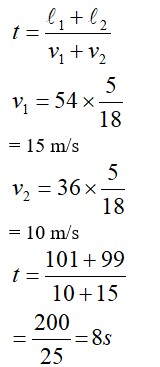3.8 On a two lane road, car A is travelling with a speed of 36 km h–1. Two cars B and C approach car A in opposite directions with a speed of 54 km h–1 each. At a certain instant, when the distance AB is equal to AC, both being 1 km, B decides to overtake A before C does. What minimum acceleration of car B is required to avoid an accident?
3.8 On a two lane road, car A is travelling with a speed of 36 km h–1. Two cars B and C approach car A in opposite directions with a speed of 54 km h–1 each. At a certain instant, when the distance AB is equal to AC, both being 1 km, B decides to overtake A before C does. What minimum acceleration of car B is required to avoid an accident?
-
1 Answer
-
3.8

Speed of car A, Va = 36 kmph = 10m/s
Speed of car B, Vb = 54 kmph = 15 m/s
Speed of car C, Vc = -54 kmph = -15 m/s
Relative speed of A, w.r.t. C = Va – (-Vb) = 10 +15 = 25 m/s
Relative speed of B, w.r.t. A = Vb-Va = 15-10 = 5 m/s
Distance between AB & AC = 1 km = 1000m
Time taken by the car C to cover the distance AC, from s = ut
We get t = 1000/25 = 40s
To avoid collision with C, the minimum acceleration the vehicle B must have, from the relation, s = ut + (1/2) ft2
We get 1000 = 5 * 40 + (1/2) f * 402 f = 1 m/s2
Similar Questions for you
Please find the solution below:
[h] = ML2T-1
[E] = ML2T-2
[V] = ML2T-2C-1
[P] = MLT-1
According to question, we can write
10 =
Average speed
(d) Initial velocity
Final velocity
Change in velocity
Momentum gain is along
Force experienced is along
Force experienced is in North-East direction.
Taking an Exam? Selecting a College?
Get authentic answers from experts, students and alumni that you won't find anywhere else
Sign Up on ShikshaOn Shiksha, get access to
- 66k Colleges
- 1.2k Exams
- 680k Reviews
- 1800k Answers



